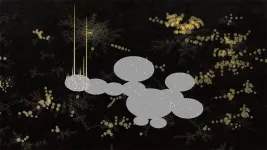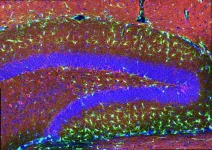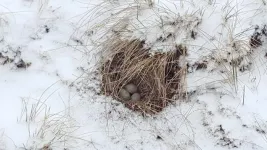(Press-News.org) DURHAM, N.C. -- Once a favored food of grazing dinosaurs, an ancient lineage of plants called cycads helped sustain these and other prehistoric animals during the Mesozoic Era, starting 252 million years ago, by being plentiful in the forest understory. Today, just a few species of the palm-like plants survive in tropical and subtropical habitats.
Like their lumbering grazers, most cycads have gone extinct. Their disappearance from their prior habitats began during the late Mesozoic and continued into the early Cenozoic Era, punctuated by the cataclysmic asteroid impact and volcanic activity that mark the K-Pg boundary 66 million years ago. However, unlike the dinosaurs, somehow a few groups of cycads survived to the present.
A new study appearing Nov. 16 in the journal Nature Ecology & Evolution has concluded that the cycad species that survived relied on symbiotic bacteria in their roots, which provide them with nitrogen to grow. Just like modern legumes and other plants that use nitrogen fixation, these cycads trade their sugars with bacteria in their roots in exchange for nitrogen plucked from the atmosphere.
What originally interested lead author Michael Kipp is that the tissues of nitrogen-fixing plants can provide a record of the composition of the atmosphere they grew up in. He combines geochemistry with the fossil record to try to understand the Earth’s climate history.
Knowing already that modern cycads are nitrogen-fixers, Kipp began analyzing some very old plant fossils during his Ph.D. work at the University of Washington to see if he could get a different look at ancient atmospheres. Most of the old cycads revealed that they weren’t nitrogen-fixers, but these also turned out to be the extinct lineages.
“Instead of being a story about the atmosphere, we realized this was a story about the ecology of these plants that changed through time,” said Kipp, who spent nearly a decade on this finding, first at UW and then as a postdoctoral researcher at CalTech.
Kipp is joining the Duke faculty this year as an assistant professor of Earth and Climate Sciences in the Nicholas School of the Environment to continue using the fossil record to understand Earth’s climate history so that we can understand its possible future.
Much of what we know about ancient atmospheres comes from chemical studies of ancient sea life and sediments, Kipp said. Applying some of those methods to terrestrial plants is a new wrinkle.
“Going into the project, there were no published nitrogen isotope data from fossilized plant foliage,” Kipp said. It took a while for him to fine-tune the method and to secure samples of precious plant fossils that museum curators were reluctant to see vaporized to get the data.
“In the few fossil samples that are of surviving (cycad) lineages, and that are not so old -- 20, 30 million years -- we see the same nitrogen signature as we see today,” Kipp said. That means their nitrogen came from symbiotic bacteria. But in the older and extinct cycad fossils, that nitrogen signature was absent.
What is less clear is how nitrogen fixation helped the surviving cycads. It may have helped them weather the dramatic shift in climate or it may have allowed them to compete better with the faster-growing angiosperm plants that flourished after the extinction, “or it could be both.”
“This is a new technique that we can do a lot more with,” Kipp said.
Funding for this study came from: The Paleontological Society, the University of Washington Royalty Research Fund, and NASA Exobiology grant NNX16AI37G.
CITATION: “Nitrogen Isotopes Reveal Independent Origins of N2-Fixing Symbiosis in Extant Cycad Lineages,” Michael A. Kipp, Eva E. Stüeken, Caroline A. E. Strömberg, William H. Brightly, Victoria M. Arbour, Boglárka Erdei, Robert S. Hill, Kirk R. Johnson, Jiří Kvaček, Jennifer C. McElwain, Ian M. Miller, Miriam Slodownik, Vivi Vajda, & Roger Buick. Nature Ecology & Evolution, Nov. 16, 2023. DOI: 10.1038/s41559-023-02251-1
END
Plants that survived dinosaur extinction pulled nitrogen from air
Nitrogen fixing bacteria may have helped some cycads survive to the present day
2023-11-16
ELSE PRESS RELEASES FROM THIS DATE:
The mind’s eye of a neural network system
2023-11-16
WEST LAFAYETTE, Ind. – In the background of image recognition software that can ID our friends on social media and wildflowers in our yard are neural networks, a type of artificial intelligence inspired by how own our brains process data. While neural networks sprint through data, their architecture makes it difficult to trace the origin of errors that are obvious to humans — like confusing a Converse high-top with an ankle boot — limiting their use in more vital work like health care image analysis or research. A new tool developed at Purdue University makes finding those errors as simple as spotting mountaintops from an airplane.
“In a sense, if a neural ...
Study finds motorist disorientation syndrome is not only caused by vestibular dysfunction
2023-11-16
Amsterdam, November 16, 2023 – A large case series aimed at understanding the factors underlying Motorist Disorientation Syndrome (MDS) has found that patients experience severe, consistent symptoms comparable to vestibular migraine. Previously there has been speculation that underlying peripheral vestibular hypofunction, when the inner ear part of the balance system is not working properly, contributes to this presentation. However, vestibular deficits were not a consistent feature in the patients studied. The findings have been published in the Journal of Vestibular Research.
In ...
Rabies virus variants from marmosets are found in bats
2023-11-16
Rabies virus variants closely related to variants present in White-tufted marmosets (Callithrix jacchus) have been detected in bats in Ceará state, Northeast Brazil.
Rabies is a deadly disease for humans. Its emergence in distinct wildlife species is a potential source of human infection and hence a public health concern. Marmosets are common in forests and conservation units throughout Brazil. In or near urban areas, they are often captured as pets and later abandoned. They have been linked ...
How a mutation in microglia elevates Alzheimer’s risk
2023-11-16
A rare but potent genetic mutation that alters a protein in the brain’s immune cells, known as microglia, can give people as much as a three-fold greater risk of developing Alzheimer’s disease. A new study by researchers in The Picower Institute for Learning and Memory at MIT details how the mutation undermines microglia function, explaining how it seems to generate that higher risk.
“This TREM2 R47H/+ mutation is a pretty important risk factor for Alzheimer’s disease,” said study lead author Jay Penney, a former postdoc in the MIT lab of Picower Professor Li-Huei ...
International team uses Insilico Medicine’s AI platform to find dual targets for aging and cancer
2023-11-16
An international research team is the first to use artificial intelligence (AI) analysis to identify dual-purpose target candidates for the treatment of cancer and aging, the most promising of which was experimentally validated. The findings were published in the journal Aging Cell.
Researchers from the University of Oslo, University of Chicago Pritzker School of Medicine, and clinical stage AI-driven drug discovery company Insilico Medicine used Insilico’s AI target discovery engine, PandaOmics, to analyze transcriptomic data derived from ...
New therapeutic strategy to reduce neuronal death in amyotrophic lateral sclerosis
2023-11-16
Amyotrophic lateral sclerosis (ALS) is a neurodegenerative disease that affects neurons in the brain and spinal cord causing loss of muscle control. A study by the University of Barcelona has designed a potential therapeutic strategy to tackle this pathology that has no treatment to date. It is a molecular trap that prevents one of the most common genetic ALS-causing peptide compounds, the Poly-GR dipeptide, from causing its toxic effects in the body. The results show that this strategy reduces the death of neurons in patients and in an animal model (vinegar flies) of the disease.
The first authors of this international research study published in the journal Science Advances are ...
Breakthrough in bladder cancer research
2023-11-16
After 40 years of treating metastatic bladder cancer with chemotherapy as a primary treatment, scientists now present a new approach using immunotherapy combinations. The results of not just one, but two studies have been presented at the European Society for Medical Oncology (ESMO) conference in Madrid. The outcomes of these studies are going to revolutionize the landscape of bladder cancer treatment.
Traditionally, cisplatin-based chemotherapy has been the standard treatment for bladder cancer patients who are able to tolerate this drug. However, responses have been limited, and durable outcomes rare. Over the past years, two phase-3 clinical trials studied the effects ...
Study: Temperature variability reduces nesting success
2023-11-16
Ithaca, N.Y.—Many songbirds are nesting earlier in spring because of warmer temperatures brought about by climate change. But the shift brings another danger that is especially deadly for nestlings: greater exposure to temperature variability in the form of cold snaps and heat waves. Such extremes result in more nest failures. These findings come from a Cornell Lab of Ornithology study just published in the journal Nature Communications.
"When we talk about temperature changes, the focus is mostly on averages," said co-lead author Conor Taff, a researcher in Cornell University's ...
Understanding survival factors in critically ill patients on extracorporeal membrane oxygenation
2023-11-16
Extracorporeal membrane oxygenation (ECMO) is a widely used advanced life support procedure that provides cardiac and respiratory support to critically ill patients. ECMO use has been increasing exponentially over the last decade as it has shown success in resuscitating patients in critical situations like the COVID-19 pandemic and is now a lifesaving treatment modality in intensive care units (ICUs). However, prolonged ECMO use may be associated with an increased risk of mortality. Identifying risk factors for in-hospital mortality and developing standardized nursing practice guidelines for ECMO management may improve the survival rates in patients.
In this vein, ...
Dr. Ralph and Marian Falk Medical Research Trust awards $1.35M to two Case Western Reserve University researchers
2023-11-16
CLEVELAND—A combined $1.35 million from the Dr. Ralph and Marian Falk Medical Research Trust was awarded to two researchers from the Case Western Reserve University School of Medicine to advance their work on finding more effective treatments—and better options—for two debilitating diseases.
The Falk Trust awarded Reshmi Parameswaran, an assistant professor in the Department of Medicine, Division of Hematology/Oncology, pathology and pediatrics at the School of Medicine, $1 million over three years for her work in cancer cell therapy.
Carlos Subauste, a professor of medicine and pathology at the School of Medicine, received a two-year, ...
LAST 30 PRESS RELEASES:
58% of patients affected by 2022 mpox outbreak report lasting physical symptoms
Golden Gate method enables rapid, fully-synthetic engineering of therapeutically relevant bacteriophages
Polar weather on Jupiter and Saturn hints at the planets’ interior details
Socio-environmental movements: key global guardians of biodiversity amid rising violence
Global warming and CO2 emissions 56 million years ago resulted in massive forest fires and soil erosion
Hidden order in quantum chaos: the pseudogap
Exploring why adapting to the environment is more difficult as people age
Society for Laboratory Automation and Screening welcomes new scientific director: Madeline M. Farley, Ph.D.
Austrian cow shows first case of flexible, multi-purpose tool use in cattle
Human nasal passages defend against the common cold and help determine how sick we get
Research alert: Spreading drug costs over the year may ease financial burden for Medicare cancer patients
Hospital partnership improves follow up scans, decreases long term risk after aortic repair
Layered hydrogen silicane for safe, lightweight, and energy-efficient hydrogen carrier
Observing positronium beam as a quantum matter wave for the first time
IEEE study investigates the effects of pointing error on quantum key distribution systems
Analyzing submerged fault structures to predict future earthquakes in Türkiye
Quantum ‘alchemy’ made feasible with excitons
‘Revoice’ device gives stroke patients their voice back
USF-led study: AI helps reveal global surge in floating algae
New method predicts asthma attacks up to five years in advance
Researchers publish first ever structural engineering manual for bamboo
National poll: Less than half of parents say swearing is never OK for kids
Decades of suffering: Long-term mental health outcomes of Kurdish chemical gas attacks
Interactional dynamics of self-assessment and advice in peer reflection on microteaching
When aging affects the young: Revealing the weight of caregiving on teenagers
Can Canada’s health systems handle increased demand during FIFA World Cup?
Autistic and non-autistic faces may “speak a different language” when expressing emotion
No clear evidence that cannabis-based medicines relieve chronic nerve pain
Pioneering second-order nonlinear vibrational nanoscopy for interfacial molecular systems beyond the diffraction limit
Bottleneck in hydrogen distribution jeopardises billions in clean energy
[Press-News.org] Plants that survived dinosaur extinction pulled nitrogen from airNitrogen fixing bacteria may have helped some cycads survive to the present day









